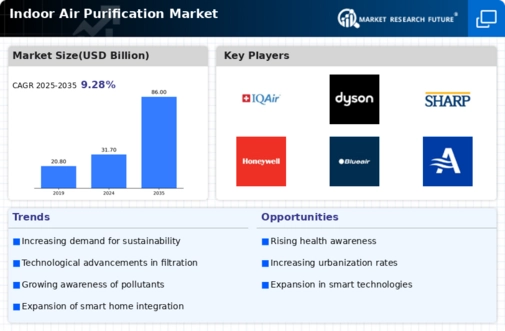Regulatory Support
Regulatory frameworks aimed at improving indoor air quality are emerging as a key driver for the Indoor Air Purification Market. Governments and health organizations are implementing guidelines and standards to address air quality concerns, which in turn encourages the adoption of air purification technologies. For instance, regulations that mandate the use of air purifiers in commercial buildings and schools are becoming more common. This regulatory support not only enhances public awareness but also stimulates market growth by creating a favorable environment for manufacturers. The Indoor Air Purification Market is likely to benefit from these developments as compliance with air quality standards becomes increasingly prioritized.
Environmental Concerns
Growing environmental concerns are significantly influencing the Indoor Air Purification Market. As awareness of climate change and pollution rises, consumers are seeking sustainable solutions to improve indoor air quality. This shift is prompting manufacturers to develop eco-friendly air purification systems that utilize energy-efficient technologies and sustainable materials. The market is witnessing a trend towards products that not only purify air but also minimize environmental impact. According to recent estimates, the demand for eco-friendly air purifiers is expected to rise, reflecting a broader consumer preference for sustainable living. This trend is likely to drive innovation and competition within the Indoor Air Purification Market.
Increased Urbanization
Urbanization is a significant factor influencing the Indoor Air Purification Market. As more individuals migrate to urban centers, the demand for effective air purification solutions escalates. Urban areas often experience higher levels of air pollution due to traffic, industrial activities, and dense populations. Consequently, residents are increasingly seeking ways to improve indoor air quality to mitigate health risks associated with urban living. The Indoor Air Purification Market is responding to this demand by offering a variety of products tailored to urban consumers, including portable air purifiers and whole-home systems. This trend is likely to continue as urban populations grow and awareness of air quality issues increases.
Rising Health Awareness
The increasing awareness regarding health and wellness is a pivotal driver for the Indoor Air Purification Market. Consumers are becoming more cognizant of the impact of indoor air quality on their overall health. Studies indicate that poor indoor air quality can lead to respiratory issues, allergies, and other health complications. As a result, there is a growing demand for air purification solutions that can effectively remove pollutants and allergens from indoor environments. This trend is particularly pronounced in urban areas where pollution levels are higher. The Indoor Air Purification Market is witnessing a surge in product innovations aimed at enhancing air quality, thereby catering to the health-conscious consumer base.
Technological Innovations
Technological advancements play a crucial role in shaping the Indoor Air Purification Market. The introduction of smart air purifiers equipped with IoT capabilities allows users to monitor air quality in real-time and adjust settings accordingly. Furthermore, advancements in filtration technologies, such as HEPA and activated carbon filters, enhance the efficiency of air purifiers in removing particulate matter and volatile organic compounds. According to recent data, the market for smart air purifiers is expected to grow significantly, driven by consumer preferences for convenience and efficiency. These innovations not only improve air quality but also contribute to energy efficiency, making them appealing to environmentally conscious consumers.


















Leave a Comment